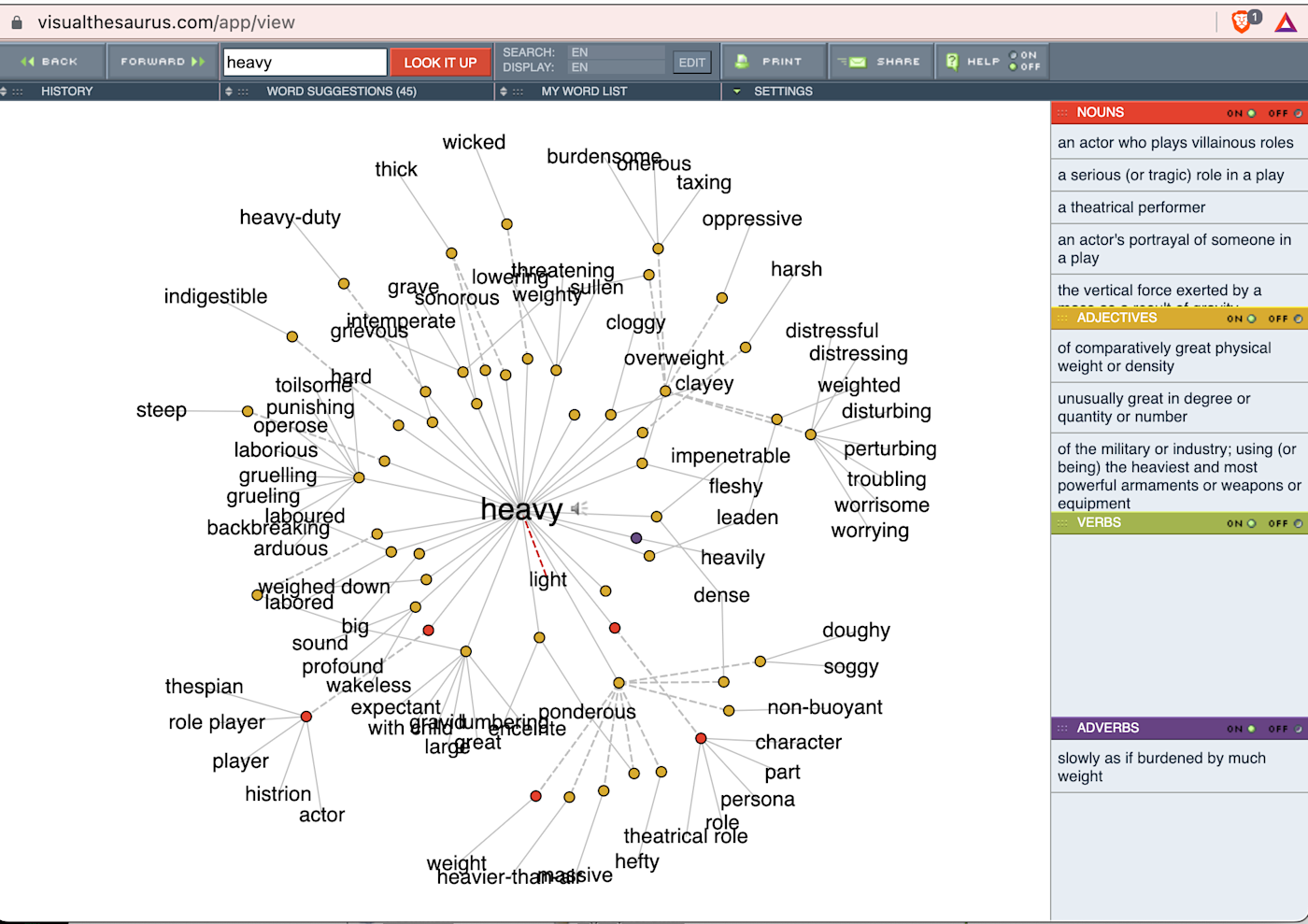A client of mine recently repositioned their brand, which included separating the product from anything that gave it a number-crunching, passive consumption feel. So instead of offering an "analytics platform," they now offer an "intelligence platform."
Of course, the platform itself hasn't changed. But they want it clear that their platform's focus is about offering precise options for smarter, faster decision-making, both strategic and tactical. Their tool doesn't provide numbers on a dashboard. It provides concrete recommendations for action and automated real-time adjustments.
When they swapped out "analytics" for "intelligence," they changed their brand lexicon in a substantial way.
What is a lexicon?
Since we're talking words, let's define our terms. A lexicon is a vocabulary list. A brand or marketing lexicon is the list of words and phrases that reflect and emphasize the brand values or marketing message you want to deliver.
Having a lexicon recognizes that a word's meaning is only part of what it communicates. Its feel and connotation also deliver a message—everything the word communicates needs to support your brand and messaging. Your lexicon is where brand voice, tone, and personality manifest.
You can have a general brand lexicon and build more targeted lexicons for specific campaigns or products. No list needs to be huge.
Some words and phrases on the lexicon are suggestions—illustrations of the phrasing that reflects brand values and messaging. An effective marketing lexicon also includes a negative lexicon: the words or phrases that should not be used. For my client, "analytics platform" is in their negative lexicon.
What purpose does a lexicon serve?
A lexicon isn't about creating content that all sounds the same, repeating the same words over and over and over. That's boring.
However, brand messaging is largely delivered in words and images, and both carry connotations beyond literal meaning. They deliver secondary information, even subtly, which needs to stay on brand. Words and phrases evoke feelings and reactions, which is why they're effective in establishing brand identity. And why you want to be sure you're using the right words and phrases to establish the identity and deliver the positive reaction you want.
Having a lexicon strengthens your branding and marketing by:
Improving the consistency of your marketing and sales channels communications. Establishing and maintaining a brand identity requires consistency. Providing clear guidance on how to talk about your brand and its offerings helps everyone from blog writers to social media managers to sales reps making calls stay on message in the right way.
Speeding up content development. If you want to create content efficiently, you need a system. A lexicon is one part of an effective content marketing machine. It helps the content creators work faster by offering clear guidance on word choices and "feel." A brand or product line lexicon also speeds up messaging as reference points for new campaigns or offerings. It ensures the targeted messaging developed remains consistent with the overall brand identity.
The groundwork you need before you can build a lexicon
If your organization has gone through a formal branding process and clarified your brand voice, you've done a lot of the groundwork already. You can turn to your in-house branding guide to start answering these questions. If it's been a while, these questions can kick off some thinking.
What ideas and values do you want associated with your organization?
What impressions do you want to project? What impressions do you want to avoid?
How do you want to position your products or services?
What type of relationship do you want to build with your customers? Do you want to be a trusted partner? Do you want to be besties?
This process sets a framework for exploring how people really talk about their challenges, your company, and what you can offer. When you start your explorations, cover these four areas.
1. How does your organization talk internally about your product and brand?
Go beyond existing marketing and sales collateral. How do your people talk informally about the problems your products solve or the pain they relieve? How do they describe these things in emails, chats, and meetings? What words and phrases does your team use when they talk about your brand mission or values? Are they consistent or inconsistent with the brand and messaging you want to build?
2. How does your potential market talk about their pain points?
Focus on how your market talks to each other about their pain points and related issues. When you use their words, phrasing, and framing back to them, it creates recognition in their minds. They see you as somebody who "gets it" or, even better, gets them. It's an important step to forging a bond of familiarity and trust.
Also listen to how prospects who are aware of you talk about your brand. Do they have the impression you want them to have? How do those who reflect your intended brand impression talk differently than those who don't, or who have a wholly distinct impression of your company?
3. How does your existing customer base talk about your product and brand?
Ask yourself many of the same questions you ask when listening to your target audience. What you hear from your customers can be especially powerful when putting together the words that have a positive impact. Let's say the word "indispensable" comes up a lot in your customer reviews and feedback—that's a potent discovery you can use. Social media and customer feedback surveys are great places to get this kind of insight.
4. How do brands you admire talk?
You're looking for brands that share your brand values, not necessarily only those in your industry. Look through their content and public communication channels; note the word choices they make that resonate with your brand values.
What to do with your research
All this listening has three goals:
Source exact words and phrases to include in your lexicon.
Open your eyes to new messaging and lexicon opportunities. You may hear a lot you didn't expect (especially if it's been a while since your last listening tour) that really sparks some aha moments.
Make you aware of some misimpressions people have and negative ways they talk about your brand, which can help you select some counter-offensive messaging and phrasing.
When you finish a period of deliberate listening to one source, create a first impression list of words and phrases that reflect your brand. Go on immediate feel and reaction when creating first impression lists. You can get reflective once everyone tasked to build the lexicon gets together to boil things down.
Also, keep a lookout for words that might detract from or undermine your brand. Just because it's a word or phrase that one or many of these groups use to talk about you doesn't mean it's a good fit for the brand or messaging you want to promote.
For example, I had a client who had an unflattering internal name for a new project. It was an easy acronym, but it was also the name of one of the more unsavory Greek gods. It was fun for some internal laughs, but as long as it was used internally, it distracted from building a positive lexicon to describe the new program externally.
What does a brand lexicon look like
I want to emphasize: your lexicon doesn't need to be huge. It should be a tool that helps people stay creative within your brand voice, not another checklist they have to review before talking or writing. Here are some things to keep in mind:
Part of your lexicon may be brand terms that must be used. Zapier is a great example. It has an entire vocabulary of words that have very specific meanings within the Zapier universe. Words like Zap, trigger, path, and Formatter.
Other items in your lexicon are representative and instructive of what on-brand, on-messaging word choice is. A brand voice that wants to communicate confidence without being condescending might include "knack" in its lexicon rather than "expertise."
Pairing a recommended word with a negative word is a great way to clarify what phrasing reflects the brand and what should be avoided. The simplest format options for these paired entries are "use this/not that" or "instead of this/use that." Having a pair highlights the difference in feel and connotation you want word choices to reflect, which helps content creators stay true to the brand lexicon without being limited to always using the words included in the lexicon.
You may also have multiple lexicons of increasingly narrow focus. Your brand lexicon is where you start and is the touchstone for more focused lexicons. You may develop persona, sub-brand, or product-specific lexicons.
Building your lexicon
Get together everyone who put together first impression lists from the listening tour, and include whoever else you think will contribute to completing a working lexicon. Go through the lists and identify the clear, consensus winners. Examine more closely what about these words or phrases make them valuable brand messengers. Do the same for words and phrases that clearly contradict the brand voice or messaging.
In both cases, think about what their connotation antonyms might be. For example, "reveal" may be too passive, so its connotation antonym could be "discover." Use this knowledge to select and remove more items from the first impression lists and create some illustrative pairs for your lexicon.
Use these discussions, which include consulting any voice, style, and messaging documentation your organization already uses, to decide what to include in your lexicon. Don't feel limited to your first impression lists. The discussion itself will reveal extra words and phrases that might also be worthwhile to include.
And don't be afraid to have some fun with multiple thesauruses (thesauri?). A few of my favorites are here, here, and here—plus this visual thesaurus.

Where does a lexicon live?
A brand lexicon should be a section in your brand style guide. You can also attach short, targeted lexicons to personas or specific messaging documentation for a new product or service.
Using your lexicon well
A lexicon is a support tool, one of many you use to develop amazing, high-impact content for your customers and your market. It's not grounds to spend endless meeting hours trying to build the perfect, complete lexicon. It doesn't exist. Nor is it grounds to churn out monotonous messaging and marketing content. Like all effective marketing campaigns and messages, revisit and refine any lexicon you use.
Every word in your marketing and sales collateral should be intentional and have a purpose, and having a lexicon helps you ensure each word carries its load.





